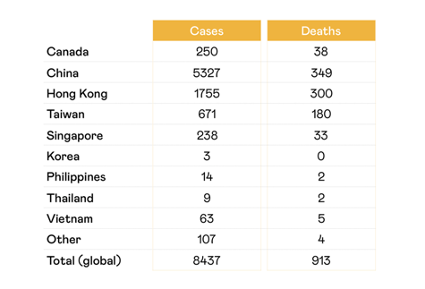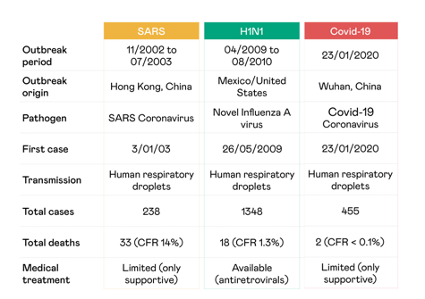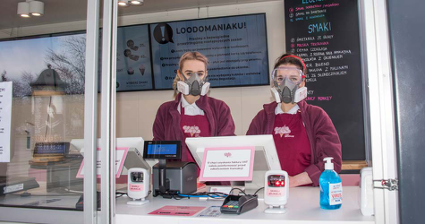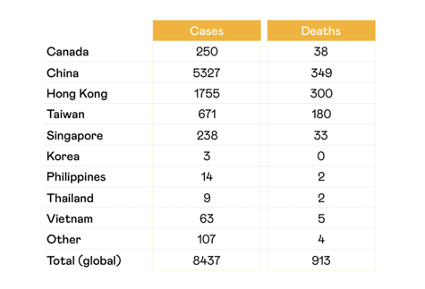Responding to global systemic shocks: applying lessons from previous crises to Covid-19
The coronavirus pandemic has spread like wildfire across the globe. It is no longer solely a health crisis, and is quickly becoming an unprecedented economic and social crisis.
The crisis clearly illustrates just how interconnected the world has become: decades of growing cross-border flows (goods, services, money, ideas, people and data) have made the world increasingly interdependent, and at the same time, increasingly vulnerable to extreme events.
Financial crises, global warming and pandemics are just three examples of the types of shocks that very quickly become systemic and global.
The coronavirus pandemic is perhaps unique in that addressing the urgency of the health crisis has forced countries to take actions that inevitably accentuate short-term negative demand supply shocks in the real economy.

The coronavirus pandemic is becoming an unprecedented economic and social crisis (Photo: Tolga Ildun/iStock)
The fact that this crisis is impacting almost all countries at much the same time is also making the situation worse. There will be time later to assess whether countries missed the boat in preparing and reacting as the crisis unfolded in China.
The reality now is that both the epidemic (in terms of the spread of infection and new cases) and the impending economic shutdown and recession are hitting the vast majority of countries concurrently, hence making it difficult for the world to organise a coordinated response that can mitigate impacts.
As governments across the world scramble to respond appropriately, it is useful to look back at how the world responded to similar global systemic shocks in the past and learn from what worked and what did not. This applies both to public health and epidemiological measures and to policies for reducing the economic costs.
There is a temptation to turn towards unilateral and isolationist policies, some of which are likely to be more counterproductive than helpful
In doing so, it is necessary to look beyond national responses and assess which global coordinated actions made a difference. In a moment when borders are closing, supply chains are fragmenting, and transport, trade and logistics networks are under stress there is a temptation to turn towards unilateral and isolationist policies (some of which are likely to be more counterproductive than helpful).
In looking back at a recent history of crises, it is also useful to examine what happened in developing countries, and not just the experience of advanced economies.
The countries currently bearing the brunt of the health crisis are all high or high-middle income. But we know from the 2008-2009 financial crisis and from the 2009 H1N1 swine flu pandemic that the economic and health impacts will spread quickly to lower-middle and low-income economies, where under-resourced systems and institutions are much less prepared to roll out an adequate response. We are already seeing signs of this as case numbers rise in Latin America, Africa, the Middle East and South Asia.
The most recent and relevant lessons come from the 2003 SARS epidemic in East Asia and the 2009 H1N1 swine flu pandemic, as well as from the 2008-2009 global financial crisis.

Monument in memory of the medical staff during the SARS outbreak, Shenzhen Central Park (Photo: Sparktour/CC BY-SA)
The 2003 SARS epidemic shaped East Asia’s public health response to Covid-19 and should help shape that of the rest of the world
It is not a coincidence that the East Asian countries that appear to have responded most effectively to the coronavirus are also those that suffered most from the 2003 SARS epidemic.
While the total number of cases and deaths associated with SARS was low relative to population (Table 1), the short-term economic shocks were significant.
More fundamentally, the experience of SARS was deeply shocking to policymakers, who found themselves hampered by: a lack of adequate surveillance systems, a lack of centralised decision-making, and a shortage of instruments for mobilising resources and supporting economically stressed sectors (and especially, for providing direct support to households affected by the economic downturn).
Hong Kong, Japan, Singapore, Taiwan and to some extent China, came out of the SARS crisis with clear lessons learnt for dealing with pandemics.
Table 1. Summary of cases by country, SARS epidemic 2003

Source: WHO.
Arguably, the most important lesson these countries extracted from the SARS experience was the significance of the state’s role in crisis management and the importance of building the state’s capacity to act, decide and manage a dangerous outbreak.
To build this capacity action is needed in four key areas:
- Invest in preparedness systems (“wide net” surveillance systems, isolation and quarantine policies and contact-tracing systems – such as the contact-tracing database system developed by Singapore that helped cut the time to trace an infected person down to a few hours).
- Centralise decision making in authorised and adequately resourced institutions (such as Taiwan’s Central Epidemic Command Centre) and/or strengthen command, control and coordination systems between government agencies (as Singapore did).
- Strengthen investment in public health and research(creating new infectious diseases programmes in major universities; strengthening relationships between public health officials and the research community; funding clinical research and building a world-class research capacity).
- Transparent and timely in public communications.
These countries also gained important clinical insights into the coronavirus family from their SARS experience, and carried out infrastructure adjustments in hospitals (including building outside waiting rooms to avoid crowding potentially infectious patients in air-conditioned emergency rooms; and installing “suction” systems in hospital air conditioning that suck viruses into hot and humid environments that destroy the virus more quickly).
When the H1N1 swine flu pandemic hit some of these countries again in 2009, the lessons from SARS were quickly applied and refined. Take the case of Singapore. Although the nature of H1N1 was quite different from that of SARS (see Table 2), the institutional structures and the health control and surveillance systems put in place during the earlier epidemic gave Singapore a head start in its response to H1N1.
Practically all the measures that were used during the SARS and H1N1 epidemics in Singapore were used again to respond quickly to Covid-19
Integrative surveillance, control tracing, physical distancing, school closings and supportive economic assistance to individuals and businesses affected by home quarantine were applied in both epidemics. Indeed, practically all the measures that were used during the SARS and H1N1 epidemics in Singapore were used again to respond quickly to Covid-19 as soon as information on the outbreak in China became known in early 2020.
Table 2. Comparing SARS, H1N1 and Covid-19 characteristics in Singapore

Source: Lai, Allen Yu-Hung and Teck Boon Tan, Austrian Journal of South-East Asian Studies 5(1), 74-101. Ministry of Health, Singapore.
The economic consequences of SARS were sharp, but short-lived. There were some supply-side disruptions, but these were dwarfed by the negative demand-side shock associated with declines in both domestic and foreign tourism, and falls in demand for services, restaurants and transport – economically important sectors in the affected countries.
Because the epidemic was brought under control relatively quickly (aided by the onset of warm weather in the third quarter of 2003), the effects were temporary and allowed for a quick economic rebound.
China’s GDP was estimated to have dropped by 5% in the second quarter of 2003, and then rebounded, leading to a loss of 0.5% of GDP for the year 2003.
In Hong Kong, GDP dropped by 10.5% in the second quarter of 2003, but the subsequent robust rebound mitigated the total impact and the result was a GDP shrinkage of 1.1% for the whole year.
The drop in annual GDP in Singapore was of a similar magnitude, and was estimated at about of 0.6-0.7% for Taiwan.
Nevertheless, these economic losses were substantial for an epidemic that affected only a few thousand people, highlighting how the behavioural component of epidemics is a major factor in shaping the economic impacts.
Lessons from SARS was most effective in terms of influencing public health policies, pandemic preparedness, clinical knowledge and methods for dealing with future pandemics. They were not as fundamental in shaping economic mitigation policies.
While most countries established programmes to support individuals and businesses affected by quarantine and isolation measures, there were few attempts to implement larger support programmes. Perhaps this was because while its economic impact was substantial (Table 2) but short-lived.
In comparison with the relatively modest impacts of SARS and H1N1, Barro et al. (2020) estimate the costs of the 1918 “Spanish flu” pandemic to be a 6.5% drop in per capita GDP (slightly less than the decline in per capita income associated with WW1). In an earlier paper, Garret (1997) summarised the results of existing research on the economic impacts of the Spanish flu in eight metropolitan areas of the United States, concluding that the impacts were large (double digit declines in firm revenues and up to 40% declines in business output in the most affected areas) but short-lived.
Because the Spanish flu affected mainly people in the 18-40 age group (e.g. of prime working age), and because it affected men more than women, some manufacturing areas subsequently saw rises in worker wages associated with a scarcity of labour.
Garret notes that there is little research that measures the social cost of the 1918 flu pandemic in terms of household poverty, child malnutrition and other social and human development outcomes. However, research does suggest long lasting impacts on the cohort that was either in utero or born during this period, highlighting the persistence of “unlucky” cohort impacts.
If the SARS epidemic provided useful lessons on the health response side, it is the Great Recession of 2008-2009 that can provide better insights as to the economic response.
The deep crisis of 2008-2009 taught us that swift action is key to preventing a downward spiral, and that without preventive policies, the long-term economic and social damage of an apparently transitory shock can be substantial. This is because there are deep asymmetries in the downward and upward parts of an economic cycle.
Firms lay off workers more quickly than they rehire them. Bankruptcies are costly and disruptive. Those countries that saw the greatest increases in unemployment during the initial part of the 2008 crisis (most notably, Greece, Italy, Portugal and Spain) also saw the steepest declines in per capita incomes, the largest increases in inequality, largest increases in poverty and the most persistent negative social and economic impacts.
The dramatic economic consequences of the Covid-19 pandemic are already playing themselves out at unprecedented scale and speed. The combination of negative supply and demand shocks emerging from Covid-19 are likely to trigger the same devastating “domino” effects we saw in the financial crisis.
If the 2008 crisis started in the financial sector and then spread to the real economy, this crisis starts in the real economy and will spread to the financial sector. Governments need to respond at scale and fast. There are signs that some are already doing so, especially in Europe.
First and foremost, governments must intervene to provide financial support for distressed companies and encourage firms to not lay off workers, as well as providing direct support to households most at risk. Worries about the fiscal cost of such measures must be pushed to the background.
Governments will have no choice but to see their debt levels rise. To support governments, central banks around the world will need to step in with the tools at their disposal: quantitative easing, and beyond that, buying distressed government bonds in the primary markets and so effectively issuing money to finance government budget deficits.
Concerns about inflation have no place in a situation in which most productive activity has ground to a halt. But even these measures will prove insufficient and some governments may find themselves unable to borrow several additional points of GDP.
In this case, a cross-country or a global facility to finance specific crisis-related measures (especially in areas with clear externalities in an epidemic context – such as health care spending) may be needed.
Indeed as governments across the world, and especially in Europe, are moving forward with “whatever it takes” packages, calls are being made for international financing backstops, such as the use of the European Stability Mechanism.
To protect workers and household incomes, a wide range of work subsidisation and social protection programmes must be expanded or rolled out. Schemes to subsidise temporary leave or short-time for workers such as those used in Germany and Poland during the financial crisis demonstrated that they can be effective and enable a faster recovery in employment following a return to growth.

To protect workers and household incomes, a whole range of social protection programmes must be rolled out (Photo: Juli Scalzi/iStock)
These are again being used extensively in countries such as Germany, Netherlands and Norway, and in a slightly different form in the United Kingdom.
Existing social protection schemes can absorb more resources and deliver them to targeted households relatively easily. Unemployment and social assistance schemes, as well as other safety nets of last resort, can be quickly expanded to cover the most vulnerable households – those without savings and assets to draw on during an extended crisis. We have seen such an expansion of unemployment benefits and flexibilisation of criteria in a number of OECD countries – including the United States.
Social protection systems play an even more important role in developing countries. In these countries, such systems often represent the only instrument available to provide income support to poor and vulnerable households (as the options of using unemployment insurance schemes or subsidised temporary lay-off schemes are limited due to the large size of the informal sector).
Fortunately, in the last two decades, the number of developing countries with some form of social safety net has doubled, from 72 in 2000 to over 150 in 2018. Much of this growth was in response to the financial crisis. This investment is about to pay off.
Table 3. % of the poorest quintile covered by social assistance

Source: ASPIRE database, World Bank.
However, not all countries will need support on the same scale. As in previous crises (for example during the 2008 Great Recession or the 2007 food price crisis), vulnerability to shocks and the capacity to respond varies greatly.
Figure 1 tries to capture this heterogeneity in exposure to risk and response capacity. The figure plots alternative combinations of two dimensions of risk (health and economic) and two dimensions of response capacity for a set of 30 “representative” nations (covering different regions and income levels).
Figure 1. How do risks and capacities towards the pandemic relate across countries

Sources: BBVA Research, Global Health Security Index, IIF, IMF, Johns Hopkins University, World Bank.
Health risk for the current pandemic is measured by combining the prevalence of detected cases in the country (cases/one million) and share represented by the older population (65+), since this group is disproportionately affected by Covid-19.
Economic risk is estimated through a combination of the forecasted overall income performance (% real GDP growth – or shrinkage – in 2020) and the share of population living on under $5.50 per day, which serves as a proxy for broad material vulnerability that goes beyond more restrictive poverty measures that would be less informative during a global depression.
Health system capacity is measured through the composite Global Health Security Index, jointly built by the Nuclear Threat Initiative and the Johns Hopkins Center for Health Security. The GHS Index groups a number of indicators that measure each country’s level of preparedness for epidemics.
Economic response capacity is summarised by the combination of tax revenue over GDP and current debt-GDP levels. Pairing both gives an idea of the resources available for sheltering the most vulnerable from adverse economic consequences.
Relating these four dimensions with each other throws additional light on links between risk, capacities and subsequent needs.
The first and most significant insight offered by the data is that no country is in perfect shape to face the epidemic. Even those showing a strong performance in most areas reveal at least one weakness.
Some European countries (France and the Netherlands, for instance) face a high health risk despite having strong health systems and good capacities for economic response.
High-income economies such as the United States may face lower health and economic risks, but have less developed social protection mechanisms for economic mitigation.
Southern European economies are already the worst affected to date (partly due to their ageing demographic structure), and have uneven economic capacities for response.
However, the capacity for economic response is even weaker in parts of Asia and Latin American middle-income countries (where health capacities also falter). Down the ladder, we find countries with considerable poverty, thin investment capacities and unprepared healthcare systems. Large African economies (Egypt, Ethiopia, Nigeria and even South Africa) as well as the whole Indian subcontinent (India, Pakistan and Bangladesh) are of particular concern and likely to require special support.
Fortunately, all of these nations are in the “green zone” of healthcare risk due to the comparatively low number of cases detected and their younger demographic profiles. But any sudden spikes in health risk will have a potentially devastating effect on their populations.
Perhaps unsurprisingly, capacities are positively correlated, suggesting the existence of “double traps” in countries such as Bangladesh. Economic risk and capacities are negatively correlated, which makes sense: countries with more vulnerable material conditions have fewer resources and tools at their disposal.
The extreme cases in these two graphs point to the most vulnerable countries and where the global community should direct its support.
The other two graphs highlight why it may in practice be very difficult to enact a sustained global response directed at more vulnerable countries. Because of the way the pandemic has played out, and because of ageing demographics in higher income countries, some of the nations now facing the highest health risks are also countries with highly developed health systems – and these nations have nevertheless been swamped by the demands of Covid-19.

An emergency hospital in Italy during the Covid-19 outbreak (Photo: Dabo Babo/Twenty20)
In other words, some of the countries that were better prepared to face the pandemic are also potentially facing the worst direct effects. Spain and Italy are tragic instances: high income economies with outbreaks taking an enormous toll on their aged populations, thus leaving them little room to consider the situation beyond their borders.
However, they must consider the wider world sooner or later: life in a heavily interconnected world means that in no small part a country’s health and economic performance largely depends on that of the rest of the world. Health is one area where there are clear geographical externalities: a failure to eradicate Covid-19 in poor countries, means that Covid-19 will reappear in rich countries the following flu season.
Similarly, if the developing countries fall into a deep recession, high income countries will feel the effects as well. If the global economy is to resume its pace, we need a concerted global effort to control the pandemic and emerge from its economic impacts. Such is the core problem of double global shocks.
Multilateral donors play an important role in the global response. Several institutions have already pledged about $64 billion of support for lower and middle-income countries. But the need is likely to be much higher – in the order of $100-$200 billion by some estimates, and these may still be underestimates.
The scope may be beyond the reach of multilateral donors alone, at least with their current tools. Bold and innovative approaches may help. The IMF recently offered to mobilise its $1 trillion lending capacity to support countries in need – and this is a step in the right direction.
The World Bank has mobilised some $16 billion to support national healthcare systems and fiscal needs. Regional development banks are similarly stepping up. But beyond the support of multilateral donors, developing countries also need coordinated global action to keep export markets open and private finance flowing.
The scale of the looming crisis in some developing countries may warrant large-scale debt relief or debt restructuring. Many of the most indebted countries rely heavily on commodity exports, especially oil, and as oil and other commodity prices plunge so do their export revenues.
Ecuador is a case in point: facing mounting cases of Covid-19 and plunging oil revenues. At the recent G20 summit, the heads of the IMF and the World Bank called on bilateral creditors to suspend debt payments for the poorest countries. But the largest creditor for many of the world’s poorest countries is China. Without its collaboration these efforts will go nowhere.
Regardless of their origin, any increased inflows will have to be targeted to build urgent healthcare and economic protections, meaning that filtering priorities will be a crucial first step for policymakers. They face the need to provide simultaneous funding for their health systems, their most affected sectors and households. The experience from previous crises in developing countries suggests that expenditures need to prioritise three areas:
- Support for containing the pandemic (mainly through the health sector)
- Support for strengthening social safety nets
- Support for measuring impacts (which populations are experiencing the greatest hardships and which firms are failing) so that scarce programme funds can be directed to those most in need. During the Ebola epidemic this was done effectively through low-cost phone surveys building on existing sample frames that gathered just-in-time information on the impacts of both ill health and economic hardship on households and firms. Similar efforts may have to be rolled out again.

Ebola screening of a passenger who arrived from Sierra Leone at Chicago’s O’Hare airport (Photo: Melissa Maraj/US Customs and Border Protection)
Some developing countries are already taking innovative steps towards preparedness and response.
For example, the Colombian capital of Bogota put in motion a multi-phased programme to tackle the rising risks of the pandemic. With less than 100 cases confirmed, the city conducted a four-day quarantine simulation devoted to fully testing the population’s capacities to remain at home for long periods of time, identifying households subject to severe income loss, as well as other weak points and potential bottlenecks.
Some developing countries are already taking innovative steps towards preparedness and response
The local administration gathered data through street and phone polling (as well as other methodologies). After the simulation was over (and while a nationwide quarantine was imposed by the central government), a guaranteed minimum income programme for 350,000 households was unveiled, enacted and implemented with the collaboration of banks and the partners such as the Red Cross.
The goal of the programme is to support poor or near-poor households during the quarantine, increase the percentage of the population who stays at home and therefore reduce the spread of the virus. To ensure inclusion, the subsidy had few strings attached.
Peru approved a similar programme when a nationwide strict quarantine was enacted by the central government. A bonus for informal and independent workers that reaches more than three million households was passed along with the quarantine. As in Bogota, the goal is to support those in need during the crisis and increase their capacity to stay home.
These are the types of simple, evidence-based programmes that countries are likely to require to simultaneously minimise healthcare and economic risks. The quicker other countries learn from these examples, the better prepared they will be to face the oncoming shocks.
Concluding remarks
Covid-19 is a global health crisis, but it is quickly becoming a global economic crisis as well. The measures needed to control the pandemic are expensive. Yet it is not the first time the world faces a global pandemic, and those countries (mainly in East Asia) that applied the lessons learnt in earlier episodes (such as with SARS) seem to have managed the current crisis better – at least from a health policy perspective.
The crisis, both in its health and economic aspects, is hitting higher income economies first. But the effects are quickly spreading to middle-income and low-income countries that have less capacity to respond. Many low-income countries (and some middle-income countries) will need global support to mobilise the resources needed to tackle the health crisis and its economic impacts.
Countries can build on the experience of addressing the financial crisis of 2008-2009 to mount a rapid, evidence-based and pragmatic economic response. Many of the instruments that were used successfully in the Great Recession can be used again.
Priorities are clear: control the spread of the epidemic; protect firms and workers from the effects of a potentially devastating but temporary demand shock; and protect the most vulnerable in society.
Some countries, such as Colombia and Peru, are already leading the way by implementing timely, straightforward and evidence-based measures to mitigate both the health risk and economic consequences of the pandemic. Other countries should take note and move quickly. The time to act is now.
EsadeEcPol Insight
Authors: Ana Revenga (Senior Fellow, Brookings Institution) & Jorge Galindo (Director of Economic Policy and Data Visualisation, EsadeEcPol)
References
- Barro, R., Urusa J.F. & J. Weng (2020). “Lessons from the “Spanish Flu” for the coronavirus potential effects on mortality and economic activity”, mimeo.
- Benassy-Quere, A., Marimom R. , Pisani-Ferry J., Reichlin L., Schoenmaker D. & Weder di Mauro B. Chapter 13 in Baldwin, R. & Weber di Mauro B. Mitigating the Covid economic crisis: act fast and do whatever it takes”, a VoxEU.org book, CEPR March 2020.
- Brambhatt, Milan & Arindam Dutta. On SARS type economic effects during infectious disease outbreaks, Policy Research Working Paper 4466, The World Bank, January 2008.
- Erce, A., Garcia Pascual A. & Roldan Mones T. The ESM must help against the pandemic: the case of Spain, VOC CEPR Policy Portal, 25 March 2020.
- Evans, D. & Mead O. The economic impact of Covid-19 in low- and middle-income countries, Center for Global Development blog, 12 March 2020.
- Gourinchas, P.O, Flattening the pandemic and recession curves, Chapter 2 in Baldwin, R. & Weber di Mauro B., Mitigating the Covid economic crisis: act fast and do whatever it takes, a VoxEU.org book, CEPR March 2020.
- Hausmann, R. Flattening the Covid-19 curve in developing countries, Project Syndicate, 24 March, 2020.
- Lai, Allen Yu-Hung & Tan, Teck Boon. Combating SARS and H1N1: insights and lessons from Singapore’s public health control measures, in ASEAS – Austrian Journal of South-East Asian Studies, 5(1), pp. 74-101. https://doi.org/10.4232/10.ASEAS-5.1-5
- OECD, From crisis to recovery: the causes, course and consequences of the great recession, Paris: September 2010.
- Pierella P., Revenga A. & Rijkers B. Coping with crises: policies to protect employment and earnings, in The World Bank Research Observer 27(1), February 2012.
- Shapiro, D. Taiwan shows its mettle in coronavirus crisis, while the WHO is MIA, The Brookings Institution, 19 March 2020.
- Lone S., Spreeuwenberg P., Lustig R., Taylor R., Fleming D., Kronerman M., Van Kerkhove M., Mounts A. & Paget J. The GLaMOR collaborating teams, Global mortality estimates for the 2009 Influenza Pandemic from the GLaMOR Project: A modeling study, in PLOS Medicine 26 Nov 2013.





